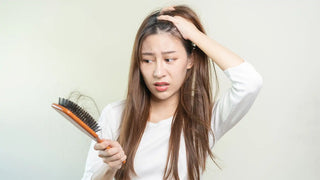 Table of contents
Table of contents
If your hair has ever felt weighed down, no matter how often you wash it, or strangely dull despite all your serums and treatments. Chances are, you need a clarifying shampoo. These detoxifying cleansers go beyond regular shampoos to remove buildup from styling products, hard water minerals, excess oil, and even pollution. But here's the catch: not all clarifying shampoo ingredients are created equal.
Some are fantastic for your scalp and strands, gently removing gunk without drying you out. Others? Not so much. Harsh surfactants, drying alcohols, and synthetic additives can wreak havoc on color-treated or curly hair. So, what should you look for and avoid when scanning that ingredient label? Let’s break it all down.
Who Needs a Clarifying Shampoo?
A clarifying shampoo is a deep-cleaning formula designed to strip away buildup that your regular shampoo might miss. It is a reset button for your hair and scalp. These shampoos are typically used once a week or even less frequently, depending on your hair type and lifestyle.
You might need a clarifying shampoo if:
- You use a lot of styling products or dry shampoo.
- Your hair feels sticky or coated.
- You live in an area with hard water.
- You swim often (chlorine buildup is real).
- Your curls have lost their bounce.
- Your scalp is oily or flaky.
Clarifying Shampoo Ingredients to Look For

Let’s start with the good guys - the clarifying shampoo ingredients that actually work without destroying your hair’s integrity.
1. Sodium Lauroyl Sarcosinate - A gentle surfactant that effectively removes oil and residue without stripping hair. It’s sulfate-free and safe for color-treated hair.
2. Disodium Laureth Sulfosuccinate - Don’t let the long name fool you. This is a much gentler cleansing agent than traditional sulfates and is commonly found in sensitive-skin-friendly formulas.
3. Apple Cider Vinegar - Naturally acidic, ACV helps rebalance the scalp’s pH, reduce excess oil, and add shine. It’s a superstar in botanical-based clarifying shampoos.
4. Activated Charcoal - Draws out impurities, toxins, and product buildup like a magnet. It’s especially great for oily scalps and those in polluted environments.
5. Tea Tree Oil - Naturally antimicrobial, tea tree oil helps treat flaky or oily scalps while offering a refreshing cleanse.
6. Witch Hazel - A natural astringent that clarifies the scalp without overdrying. Great for oily and acne-prone scalps.
7. Salicylic Acid - This beta-hydroxy acid exfoliates the scalp and helps dissolve excess sebum, making it perfect for those with dandruff or clogged follicles.
8. Kaolin or Bentonite Clay - Absorbs oil and grime from the scalp and hair, offering a natural detox without the need for sulfates or alcohols.
Clarifying Shampoo Ingredients to Avoid

Now for the bad guys. These ingredients may clean your hair, but they can do so at a high cost, like dryness, irritation, or color fading.
1. Sodium Lauryl Sulfate (SLS) - An extremely harsh surfactant that removes not just product buildup, but also your scalp’s natural oils and moisture barrier.
2. Ammonium Lauryl Sulfate - A cousin to SLS, equally aggressive. It’s less common now, but is still used in budget clarifying formulas.
3. Formaldehyde Releasers - Used as preservatives, but linked to scalp irritation and long-term sensitivity.
4. Alcohol Denat - Common in cheaper formulas, these alcohols can leave hair brittle, especially if used regularly.
Choosing the Right Clarifying Shampoo by Hair Type
When it comes to clarifying shampoos, one size doesn’t fit all. Your hair type plays a crucial role in choosing the right formula. For oily scalps prone to buildup, ingredients like clay, charcoal, citrus extracts, and salicylic acid offer a deep cleanse that lifts away excess sebum without over-stripping. On the other hand, dry hair types benefit from sulfate-free formulations rich in soothing botanicals that clarify gently while preserving moisture.
Curly hair, which is naturally drier and more porous, requires extra care - gentle surfactants like sulfosuccinates, combined with nourishing oils or aloe, help detox the scalp without disrupting the curl pattern. Meanwhile, color-treated hair needs mild, pH-balanced shampoos that avoid harsh sulfates and alcohols; ingredients like apple cider vinegar and witch hazel are ideal for maintaining vibrancy while eliminating residue.
How Often Should You Use Clarifying Shampoo?
This depends entirely on your hair type, scalp condition, and lifestyle. If you have an oily scalp, use many styling products, or swim regularly in chlorinated water, clarifying once a week helps eliminate buildup and impurities effectively. For those with a normal scalp and minimal product use, clarifying once every week is usually sufficient to maintain a healthy balance. However, if your hair is dry, color-treated, or naturally curly, it’s best to limit clarifying to once every 3 to 4 weeks, as these hair types are more prone to dryness and breakage. No matter your schedule, always follow up with a deep conditioner or hydrating mask to restore moisture and protect your strands.
FAQs
1. Is clarifying shampoo safe for color-treated hair?
It depends on the ingredients. Avoid harsh sulfates and drying alcohols. Choose sulfate-free options like Moehair Clarifying Shampoo.
2. What’s the difference between clarifying and detox shampoos?
Often used interchangeably, “clarifying” refers to removing product buildup, while “detox” may also focus on pollution and impurities. Always check the clarifying shampoo ingredients to see what you're really getting.
3. Are all sulfates bad?
Not necessarily. Some sulfates, like Sodium Lauroyl Sarcosinate, are milder and less drying.
4. Why does your hair feel dry after using a clarifying shampoo?
Clarifying shampoos remove oils along with buildup. Always follow up with a good conditioner or mask to restore hydration.
References
https://www.healthline.com/health/beauty-skin-care/shampoo-ingredients-to-avoid
How we reviewed this article:
Our experts continually monitor the fashion and beauty space, and we update our articles when new information becomes available.
-
Current Version
-
June 19, 2025
Written and Edited By -
Utsav Baghel is a seasoned researcher with over five years of industry experience in technical and academic writing.






















